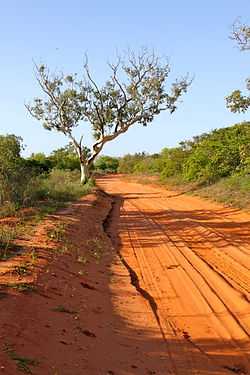Pindan


Pindan is a name given to the red-soil country of the south-western Kimberley region of Western Australia. The word “pindan” was first mentioned in print in August 1884 in the Perth Inquirer. The term comes from a local language and applies both to the soil and to the vegetation community associated with it.[1]
Geography
Pindan country is geographically restricted to Dampierland, including the Dampier Peninsula and its hinterland, the area around Broome and Roebuck Bay, and a coastal strip extending south-westwards from Roebuck Bay adjacent to Eighty Mile Beach. It is semiarid with a tropical monsoonal climate of hot, wet summers and mild, dry winters. The flat, or gently undulating, land lacks prominent landmarks and is easy to get lost in.[1] The soils are usually red and sandy with a high clay content, low in nutrients, and susceptible both to drought and to waterlogging when wet.[2][3]
Flora and fauna
Botanically the pindan forms a transitional zone between the wetter monsoon forests of the north Kimberley and the Great Sandy Desert to the south-east, exhibiting a mix of monsoonal and arid species. Structurally it is a low and open woodland of scattered trees, dominated by wattles, with eucalypts and tall shrubs. The understorey contains grasses and herbs. During the long dry season from April to November the annual plants and grasses die off, the country looks parched, and regular wildfires leave stretches of bare and blackened soil, studded with dead shrubs. During the short wet season from December to March there is profuse flowering of the diverse pindan flora, with a wide variety of insects and other animals taking advantage of the seasonal abundance.[1]
On higher ground, pindan adopts a more open savanna structure while, on low-lying ground subject to waterlogging during the wet season, paperbarks begin to displace the other trees. Canopy height ranges from 3 m to 8 m; the trees are short and deep-rooted, often with the trunks bent or twisted. In his 1926 book “In Savage Australia” Norwegian explorer Knut Dahl described the pindan as a “crippled forest” in response to the apparent uniformity and stunted appearance of the vegetation.[1]
Typical species of trees and tall shrubs in pindan vegetation are the wattles Acacia eriopoda, A. tumida, A. monticola, A. platycarpa, A. colei, and A. adoxa, and the eucalypts Eucalyptus dampieri, E. flavescens, and E. zygophylla. Other plants include Grevillea wickhamii and G. refracta, Gyrocarpus americanus, Terminalia petiolaris, Lysiphyllum cunninghamii, Ventilago viminalis, Premna acuminata, Hakea microcarpa, Persoonia falcata, Atalaya hemiglauca, Gardenia pyriformis, Pavetta kimberleyana, Carissa lanceolata, Distichostemon hispidulus, Ehretia saligna and Santalum lanceolatum.[4][5]
Many savanna animals, such as Agile Wallabies and Red-winged Parrots reach their southern limits in Western Australia in the strip of pindan that parallels the coast along Eighty Mile Beach.[1]
Further reading
- Dahl, Knut (1926). In Savage Australia. An account of a Hunting and Collecting Expedition to Arnhem Land and Dampier Land. London: Philip Allan & Co.
- Kenneally, K.; Edinger, D.; and Willing, T. (1996). Broome and Beyond: Plants and people of the Dampier Peninsula, Kimberley, Western Australia. Perth: Department of Conservation and Land Management, Western Australia.
References
Notes
Sources
- Lowe, Pat (2003). Pindan Woodlands. Environs Kimberley.
- "Broome: Soils". Water Corporation. Retrieved 13 April 2010.
- "Information Sheet on Ramsar Wetlands: Roebuck Bay". Department of Conservation and Land Management, Western Australia. October 2003. Retrieved 13 April 2010.
- "Kimberly tropical savanna". Terrestrial Ecoregions. World Wildlife Fund. Retrieved 13 April 2010.
- "Soils of the Kimberley". Kimberley Development Commission. Retrieved 13 April 2010.